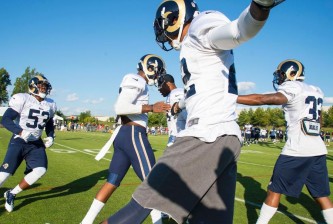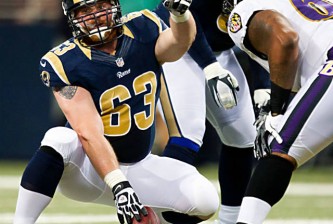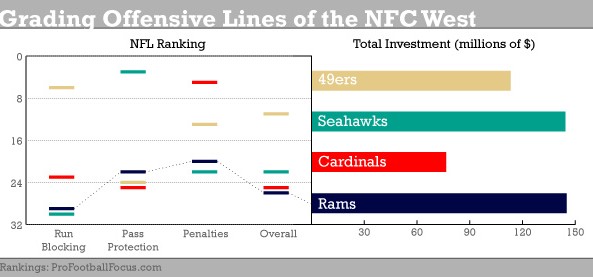
Rams center Jason Brown signed the richest contract ever for a center in 2008. Says PFF’s Khaled Elsayed, “he has yet to go any way toward earning that big deal.”
Since Billy Devaney came to the Rams, St. Louis has committed more money to the offensive line than any other team in the division: a total of $145 million dollars in signed contracts.* Despite this heavy investment, Pro Football Focus still ranks our line as the worst in the NFC West, behind the decrepit Cardinals and the rebuilding Seahawks, and far behind the newly physical 49ers.
While we may like to brag about having the best quarterback in the division (a claim that could only be made in the NFC West at this point, regardless of Bradford’s sky-high upside), it won’t do us much good if we can’t keep him upright.
Improving the line
In 2007, the Rams line was pretty much bad all over. Pass protection sucked. Run blocking sucked. And we were among the most-penalized units in the league, thanks to the efforts of young Alex Barron, our supposed hope for the future.
To his credit, Devaney acted swiftly, clearly prioritizing this area while other teams (the Lions and Bears come to mind) chase big-ticket skill players while their interiors crumble.
The Rams signed LG Jacob Bell from Tennessee and C Jason Brown from Baltimore to big-money contracts, and drafted tackles Jason Smith and Rodger Saffold with 1st and 2nd round picks. (Supposedly, Devaney’s first ever draft pick as GM would have been LT Jake Long in 2008, but the Dolphins beat him to the punch.)
Among these acquisitions, a pattern becomes clear: none of these players are big, physical brutes for their positions. Rather than send his scouts to the weight bench, counting reps, the Rams appear to prioritize foot speed, athleticism, and versatility.
Smith was a former big-framed tight end who has been a project as a conversion to tackle. Brown can play center and guard, and did both at times in the preseason. Saffold has shown an ability to play equally well on the left or right side of the line, and Adam Goldberg, the lone survivor from the pre-Devaney era, is basically a super-sub that has filled in at right tackle, left guard and right guard over the past three seasons.
We’re happy that the line has received this much attention. But are the Rams getting their money’s worth?
Grading their performance
Pro Football Focus has developed a rating system that is entirely based on scouting. They have assembled a small army of analysts who watch game tape and grade every player on every play – a herculean task that results in a set of decimal numbers ranging from positive to negative. And they split out those grades on discrete areas of game play. In particular, offensive linemen are judged on “pass protection,” “run blocking” and “penalties.”
As you can see from this chart, the only area that our offensive line’s performance doesn’t totally suffer is in penalties. Even there we rank 20th among NFL teams. Moreover, each of the other teams in our division has at least one element of the game in which they grade far superior to our unit.
However, an alternate grading metric by Football Outsiders — which focuses only on statistical measures, not on scouting — gives the Rams a much more pronounced rise in pass protection:
| Year | Run Blocking Rank (Adjusted Line Yards) |
Pass Protection Rank (Sack Rate) |
|---|---|---|
| 2007 | 28th (3.72 yds) | 26th (8.1%) |
| 2008 | 28th (3.73 yds) | 23th (7.8%) |
| 2009 | 28th (3.86 yds) | 24th (7.7%) |
| 2010 | 26th (3.77 yds) | 10th (5.6%) |
The FO stats show a huge and sudden jump in improvement in sack rate, a sign that Devaney’s investments are finally paying off, right? Or, it could be that Sam Bradford is much more elusive than Marc Bulger was, and that for a rookie, his decision-making with the football was exceptionally fast, thus bailing out his line.
Two seasons ago, the Rams line graded near the bottom of any reasonable analyst’s rankings. But there were reasons to believe that big improvements were on the way. Heading into 2011, though, our line has been invested in heavily, with little immediate returns to show for it.























